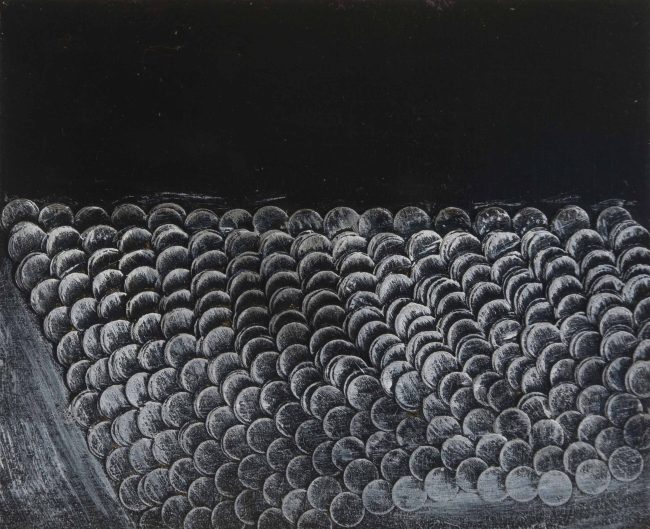Collages at Waterhouse & Dodd

Collage 115 (Wave 1), 1983, Acrylic on paper on card, 8.6 x 10.5 cm, BGT1961
A Virtual Exhibition of Wilhelmina Barns-Graham’s collages is viewable and available for sale with Waterhouse & Dodd.
The first collages that Wilhelmina Barns-Graham made coincided with periods of ill health during which the ability to work on a large scale was restricted to what she could do sitting down. Initially small in size, the collages are made up off tiny hole-punched pieces of paper and card, the surfaces built up bit by bit. As Barns-Graham continued to develop them, a few larger scaled pieces were made, the largest by far being 160 cm wide! However most remained small.
One can more accurately call the collages painted reliefs, a term which Barns-Graham herself used in some of the titles. The first appeared in 1982. During the next five years she made close to 200, the last being from 1987. This is a significant body of work which, alongside the small energy drawings Barns-Graham worked on simultaneously, defines her work in that decade. One cannot say that among modern British artists of her time she was unique in making collages, but such an extensive body of work is particularly exceptional and quite extraordinary. In this she is certainly unique, and particularly more so within the context of her St Ives peers .
Barns-Graham had made reliefs once before, in the mid-1950s. Those reflected the hard-edged abstraction of the period. They were simpler than her paintings but lacked none of their visual strength. However, the collages from the 1980s are very different both in format and construction.
The collaged reliefs relate to Things of a Kind Order and Disorder, a significant series that ran from the early 1960s and through much of the 1970s. They are more complex in their arrangements and use of colour but share similar concerns on form and movement. Some have clearly evolved from the more contemporaneous Family Series and Tribute Series with their flying panels being manipulated across the picture surface. A further point is that the viewer is not made fully aware of whether one is perceiving something large on a small scale or, conversely, a small subject enlarged.
They can evoke experiences of landscape but Barns-Graham is usually unspecific regarding the genesis of her ideas. One exception in this group is Warbeth 3 which does reflect her experience of a particular place. Warbeth is located on the west side of Orkney’s main island where she first visited in 1984. There she discovered the remarkable coastal geology with its platform strata that extends out to sea. The palette in this collage is inspired by the rock, water and the rusting hulk of an old beached trawler that sits atop the strata. Also inspired by Orkney (but to lesser degree), Construction Painting (Red, Orange and Blue on Grey) takes its starting point from the strata at the north edge of the island where the palette is more green/grey in hue. Nonetheless the two collages are not intended as illustrations of those locations. Rather, they reveal the way in which she syntheses her experiences within her art practice.
The on-line exhibition continues until end of May. For further details contact the gallery at https://www.waterhousedodd.com
